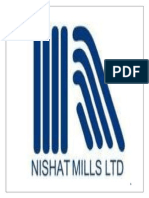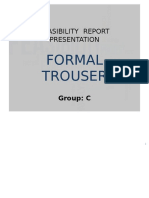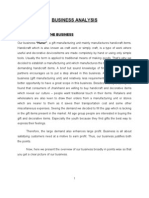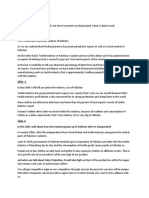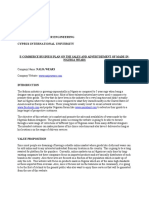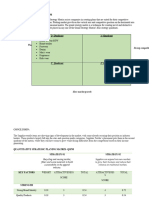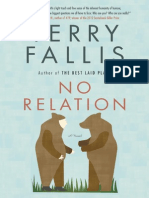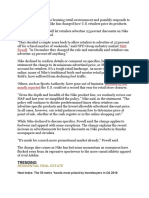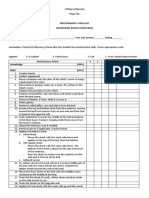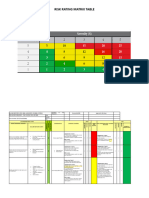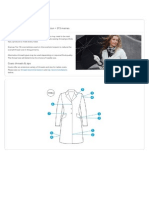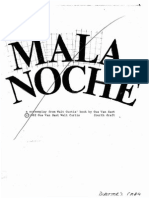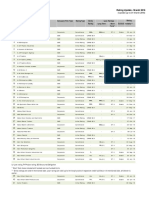International Marketing
Management Report
On
“Export pashmina fabrics From India to USA”
Submitted to
Dr. Amisha Gupta
Submitted By
KM Deepanjali Tyagi (FC22141)
Himanshi Bambah ( FC22139)
Mayank Raghav ( FC22144)
Mansi Solanki ( FC22143)
Yashi Jaiswal ( FC22138)
1
� ACKNOWLEDGMENT
We would like to express our heartfelt gratitude to everyone who contributed to the successful
completion of this project.
Special thanks to faculty mentor, Dr. Amisha Gupta, for their guidance, encouragement, and
valuable feedback throughout the project.
We are also grateful to fellow mates and whole team, for their collaboration and support, which
made this experience both enjoyable and fulfilling.
Lastly, we want to acknowledge Dean PGDM, Dr. Pratima Daipuria, JIMS, Rohini, for providing
me with this valuable opportunity to learn and grow professionally.
Thank you all for being a part of this project.
KM Deepanjali Tyagi- FC22141
Mayank Raghav - FC22144
Himanshi Bambah - FC22139
Mansi Solanki- FC22143
Yashi Jaiswal – FC22138
PGDM Batch 22-24
2
� Table of Contents
Page No.
Acknowledgement 2
Executive Summary 4
Objectives 6
About Pashmina Fabrics 6
Market Analysis 7
Marketing Plan 9
Success factors 10
Challenges 10
Conclusion 11
Learnings 12
References 13
3
� Executive Summary
Product in which we are dealing (import/export) – PASHMINA FABRIC
Place where we are exporting – U.S. (specifically North America)
Pashmina fabric is the art and bread-&-butter for the Kashmiri people. We are also
dealing in this by exporting raw-spun pashmina fabric to the textile players of US
market where it will, later, converted into finished products like Scarf, jacket,
Muffler etc. How we will procure pashmina? As In the Changthangi mountain of
the Ladakh region, a rare breed of goats dwell. They are the Changra breed of goats.
Also known as Kashmir Goats. The Changra goats dwell in the harsh winters as well
as in summer. In the winter season, they develop thick and soft wool on their bodies
to withstand the chilly cold. The medium-sized Changra goats shed this wool off
when it comes to summer. The Changra goats rub their bodies against rocks, trees to
feel the air of summer. Also combed out manually by the herders. Now, extracted
wool sent to the Kashmir where further process took place. Starts from cleaning
the raw wool then combing it so that they are carded into light group of fibres then
glueing starts. Here, rice powder sprinkled on the pashmina (to give it an extra
strength, moisture and softness) and left for a night. After completion of glueing,
now, spinning of the wool take place manually with the help of YINDER (it’s a
traditional equipment used by Kashmiri). This is the skillful operation which generates
delicate and spun yarn.
For further process, it will be exported to North America. In the recent scenario,
North American market is currently flooded with Grade B pashmina approx. 70%
which is not up to when it comes to quality (rough and scratchy) compare to
Pashmina Wool. We are planning to enter U.S. market by STRATEGIC
ALLIANCE with TEXTILE INDUSTRY PLAYERS so it’s purely B2B entry.
Why U.S.? There are several others reasons like GDP, Good Bilateral trade
connections, Good Political connections, Growing economy, Growing personal
disposable income but main reason ,We, feel is that LEGAL NORMS OF U.S. – 2
Laws are there TEXTIILE AND APPAREL LABELLING ACT and WOOL
PRODUCT LABELLING ACT. These acts not only bolster our product in terms of
Quality, Purity and Place of manufacturing but also give recognition of the
4
�craftsperson, in the international market, who manufactures it. If any brand not
adheres to these acts will be penalized by FEDERAL TRADE COMMISSION
(FTC) (jail or $16,000 as a fine or both). Upcoming Market opportunity is also very good
for pashmina fabric as current market size is $120 M which was expected to grow
by $150 M in 2027. We are providing the top-notch material compare to current
Grade B pashmina, which is scattered in the U.S. market, to the innovative, cost-
effective and best textile players who supports us and our product with help of their
innovation and technological advancements to make it more superior and helpful for
the native people.
5
� Objectives
• To ensure consistent quality and craftsmanship of Pashmina fabrics in
international markets.
• To grow the customer base and reach a global audience of luxury fashion
consumers.
Overview about Pashmina fabrics
Pashmina is considered the finest craftsmanship in the world which transforms the
exceptionally warm and delicate Cashmere threads to opulent accessories. The
fleece of Changthangi Goat is known as Pashm which is an Urdu word & has origins
in Farsi. This goat is exotic and is only found there, 15000 feet above sea level in
Ladakh – Jammu and Kashmir, making the art of Pashmina even rarer and revered
all over the world. Pashmina has fascinated kings, royals, and people all over the
world by its magical allure and a traditional grace. Perhaps this was the reason why
we chose to showcase the exquisiteness and regal demeanour of this centuries old
art to the world.
6
� Market Analysis
COMPETITOR ANALYSIS
The top pashmina fabric brands in the USA market in 2023 are:
➢ SILVERHOOKS (15% MARKET SHARE)
➢ BETSEY JOHNSON (10% MARKET SHARE)
➢ BOHMÓNDE (8% MARKET SHARE)
➢ SAKKAS (7% MARKET SHARE)
➢ PEACH COUTURE (6% MARKET SHARE)
These brands are known for their high-quality pashmina fabrics and their wide range of products,
including shawls, scarves, stoles, and wraps. They also offer a variety of colours, patterns, and
styles to choose from.
PESTEL ANALYSIS
•The import tariff is •US GDP will increase •The US population is
14% when it comes from US$ 26.24 diverse and
to pashmina. trillion in 2023 to US$ multicultural, with a
•Harbor maintenance 39.23 trillion in 2033. growing appreciation
fee: is 0.25% of the •US disposable income for different cultures
ECONOMIC
value of the goods & has increased by 6% and products.
POLITICAL
and the Merchandise from the last year. •There is a growing
SOCIAL
processing fee: is Thus, Purchasing trend towards ethical
0.3464% of the value Power increases. and sustainable
of the goods. consumption, which
could benefit the
pashmina
fabric industry.
7
� •USA is a leader in •The US government •One of the most
the development of has a number of important legal
new and innovative regulations in place norms is the Textile
pashmina fabric to protect the and Apparel
technologies. environment. There Labeling Act (TALA)
•More company- is a growing & Wool Products
specific example:– consumer demand Labeling Act
Nano-Tex (Michigan for eco-friendly (WPLA). TALA &
ENVIRONMENTAL
Based Company)– products. WPLA requires that
TECHNOLOGICAL
They develop Nano •The pashmina fabric all textile products,
textile coatings that industry is relatively including pashmina
can be applied to sustainable, as products, be
LEGAL
pashmina fabrics to pashmina wool is a accurately labeled.
improve their water natural fiber that is •This means that the
repellency, stain renewable and label must state the
resistance, and biodegradable. fibre content of the
flame resistance. product, as well as
the country of
origin. WPLA
requires that wool
products be labeled
with the name and
address of the
manufacturer or
distributor. All this
monitored by the
Federal Trade
Commission. FTC
can take action
against businesses
that violate these
laws, including fines
and injunctions.
8
� Marketing Plan
STP for Pashmina fabrics in USA
Segmentation : Demographic (occupation)
Targeting : Fashion designer and boutique
Promotion : Symbol of elegance and luxury
4’p for pashmina fabrics
Product: High quality pashmina fabric
Price: Premium pricing
Place: Tapping US market with strategic alliance
Promotion: Direct selling
Entry Mode
By partnering with a well-established American textile company, we can benefit
from their expertise in navigating the complex U.S. market, understanding customer
preferences, and complying with local regulations. Strategic alliances can provide a
smoother entry into the market and help us build relationships with key players in
the textile industry.
9
� Success factors of the project
• Best technology support from the textile players who are currently working in
the US market which also helps in establishing good B2B relationships (Nano-
tex(Michigan based co.) develops Nano-textile coating to improve pashmina & Pashmina
house(US based co.) has developed a proprietary pashmina spinning technology that
produces a finer and more durable yarn that can process the delicate pashmina fibers
without breaking them)
• Political (PM also focuses on Bilateral trade during the meet with Mr. Biden)
and Legal support which also adds value to the craftsman of pashmina (with
the help of Wool products labeling act, 1939 monitored by FTC)
• Maintaining purity of pashmina content in the fabric (which was monitored
by FTC under Textile and apparel labeling act)
• Big market opportunity to grab for pashmina fabric ( 2023- $120M & till 2027
- $150M)
Challenges faced in completion the project
• Unauthorized source of information
• Cultural differences/ preferences differences
• Rapidly change global market
• Choose the country for expansion
• Choosing the mode of entry is most critical.
10
� Conclusion
In conclusion, exporting Pashmina fabrics from India to the USA presents a
promising opportunity marked by rich cultural heritage, exceptional quality,
and growing demand. Leveraging India's skilled craftsmanship and the USA's
appreciation for luxury textiles, this trade avenue holds immense potential for
fostering bilateral relationships and catering to the discerning tastes of
consumers in the American market. As the demand for premium, ethically
sourced textiles continues to rise, the export of Pashmina fabrics stands poised
to flourish, offering a harmonious blend of tradition, quality, and elegance to
an international audience.
By leveraging the unique appeal of Pashmina and addressing logistical
challenges, Indian exporters can tap into the American market and contribute
to the global appreciation of this exquisite fabric.
Establishing a strategic alliance for exporting pashmina fabrics from India to
the USA offers a promising pathway to leverage expertise, resources, and
market access. This entry mode enables shared risks, enhanced market
penetration, and access to local networks, fostering a mutually beneficial
relationship between Indian suppliers and American markets. Leveraging a
strategic alliance not only facilitates cultural alignment and distribution
channels but also promotes innovation and competitiveness, fostering
sustainable growth in the lucrative pashmina fabric trade between these two
countries.
11
� Learnings
• Gained knowledge about important factors while expanding the business
internationally. Which means Expanding internationally involves
understanding local laws and regulations, which vary by country. In the U.S.,
for instance, importing and selling Pashmina products would require
compliance with customs and trade regulations, ensuring product safety, and
meeting labeling requirements.
• Analysing the risks associated with product launch Factors like market
demand, competition, and potential legal challenges. For Pashmina,
understanding intellectual property laws is crucial to protect against
counterfeit products, ensuring the authenticity and quality of the merchandise.
• Know about the legal norms of USA, there are TEXTIILE AND APPAREL
LABELLING ACT and WOOL PRODUCT LABELLING ACT. These acts
not only bolster our product in terms of Quality, Purity and Place of
manufacturing but also give recognition of the craftsperson, in the
international market, who manufactures it.
12
� References
• India-us-relations
• Source
• https://www.pashmina.com/what-is-pashmina
13
